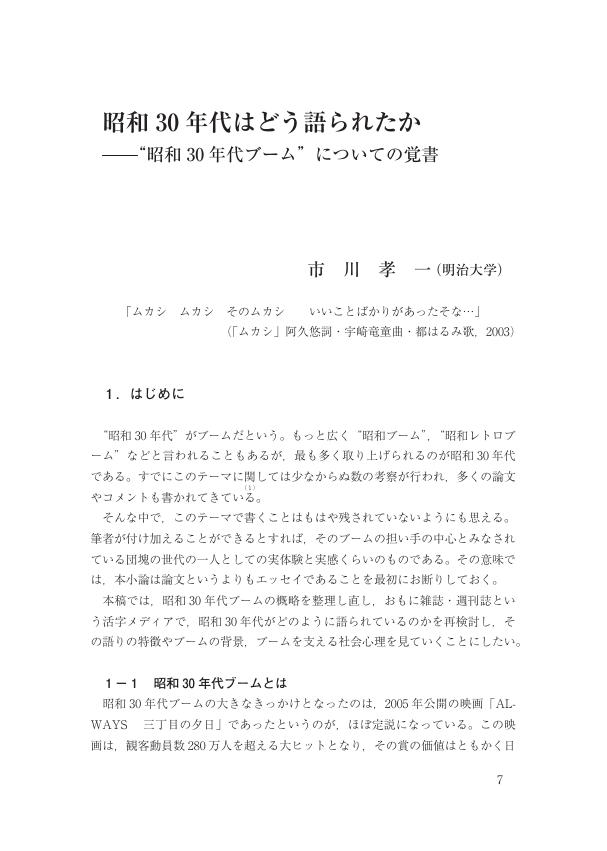112 0 0 0 OA 外国人による婦女暴行デマとその背景
- 著者
- 市川孝一
- 出版者
- 文教大学
- 雑誌
- 生活科学研究 = Bulletin of Living Science (ISSN:02852454)
- 巻号頁・発行日
- vol.14, pp.30-40, 1992-04-01
40 0 0 0 OA 日本人の飲酒行動と規範
- 著者
- 市川孝一
- 出版者
- 文教大学
- 雑誌
- 生活科学研究 = Bulletin of Living Science (ISSN:02852454)
- 巻号頁・発行日
- vol.20, pp.17-26, 1998-03-01
4 0 0 0 IR 社会問題化した広告表現 : 炎上CMから見えてくるもの
- 著者
- 市川 孝一
- 出版者
- 明治大学文芸研究会
- 雑誌
- 文芸研究 : 明治大学文学部紀要 (ISSN:03895882)
- 巻号頁・発行日
- no.134, pp.84-60, 2018
4 0 0 0 社会問題化した広告表現 : 炎上CMから見えてくるもの
- 著者
- 市川 孝一
- 出版者
- 明治大学文芸研究会
- 雑誌
- 文芸研究 : 明治大学文学部紀要 (ISSN:03895882)
- 巻号頁・発行日
- no.134, pp.84-60, 2018
4 0 0 0 OA マンガ同人誌の保存と利活用に向けて : コミックマーケットの事例から
- 著者
- 市川孝一
- 出版者
- 国立国会図書館
- 雑誌
- カレントアウェアネス (ISSN:13487450)
- 巻号頁・発行日
- no.297, 2008-09-20
2 0 0 0 OA 社会問題化した広告表現 -炎上CMから見えてくるもの-
- 著者
- 市川 孝一
- 出版者
- 明治大学文芸研究会
- 雑誌
- 文芸研究 (ISSN:03895882)
- 巻号頁・発行日
- vol.134, pp.(51)-(75), 2018-02-28
2 0 0 0 OA 昭和が終った日 : 天皇「崩御」のニュースはどう受け取られたか
- 著者
- 市川孝一
- 出版者
- 文教大学
- 雑誌
- 生活科学研究 = Bulletin of Living Science (ISSN:02852454)
- 巻号頁・発行日
- vol.12, pp.7-16, 1990-04-01
2 0 0 0 OA 商品の記号的価値について : 「消費の記号化現象」再考
- 著者
- 市川孝一
- 出版者
- 文教大学
- 雑誌
- 生活科学研究 = Bulletin of Living Science (ISSN:02852454)
- 巻号頁・発行日
- vol.17, pp.37-46, 1995-03-01
1 0 0 0 OA 1960年代末の若者文化-フーテン(族)とヒッピー(族)についての覚書-
- 著者
- 市川 孝一
- 出版者
- 明治大学文学部文芸研究会
- 雑誌
- 文芸研究 (ISSN:03895882)
- 巻号頁・発行日
- vol.128, pp.(21)-(42), 2016-02-29
1 0 0 0 OA 酒の生活学 : 日本人の飲酒行動と飲酒文化
- 著者
- 市川孝一
- 出版者
- 文教大学
- 雑誌
- 生活科学研究 = Bulletin of Living Science (ISSN:02852454)
- 巻号頁・発行日
- vol.9, pp.42-51, 1987-04-01
- 著者
- 市川 孝一
- 出版者
- 文教大学
- 雑誌
- 生活科学研究 = Bulletin of Living Science (ISSN:02852454)
- 巻号頁・発行日
- no.13, pp.23-38, 1991-04-01
1 0 0 0 IR 1960年代末の若者文化 : フーテン(族)とヒッピー(族)についての覚書
- 著者
- 市川 孝一
- 出版者
- 明治大学文学部文芸研究会
- 雑誌
- 文芸研究 : 明治大学文学部紀要 (ISSN:03895882)
- 巻号頁・発行日
- no.128, pp.148-127, 2016
1 0 0 0 OA 昭和30 年代はどう語られたか
- 著者
- 市川 孝一
- 出版者
- 日本マス・コミュニケーション学会
- 雑誌
- マス・コミュニケーション研究 (ISSN:13411306)
- 巻号頁・発行日
- vol.76, pp.7-22, 2010-01-31 (Released:2017-10-06)
- 参考文献数
- 16
1 0 0 0 OA 若者論の系譜 : 若者はどう語られたか
- 著者
- 市川 孝一
- 出版者
- 文教大学
- 雑誌
- 人間科学研究 = Bulletin of Human Science (ISSN:03882152)
- 巻号頁・発行日
- vol.25, pp.123-130, 2003-01-01
The purpose of this paper is to review books, articles and essays on youth and youth-culture in post-war Japan. People born after World War Ⅱ are divided into four generations, according to the time when they become adolescent.— 1960’s: Dankai-no-Sedai (first baby boomer in post-war period), 1970’s:Shirake-Sedai (apathy generation), 1980’s:Shinjinrui-Sedai (new-species generation), 1990’s:Dankai-junior Sedai (second baby boomer in post-war period). \nCharacteristics of each generation are described as follows: Dankai-no-sedai: spirit of resistance and protest, Shirake-Sedai: apathy and moratorium, Shinjinrui-Sedai: super-individualistic, ego-centric, Dankaijunior-Sedai: indifferent to others, lack of imagination. \nThese characteristics and traits have been gradually generalized as those of common Japanese in later times. And Japanese mass-culture has been influenced by youth-culture. Youth and youth-culture is a significant indication of future images of people and culture in general. It is the reason why we examine the changes of these features.
1 0 0 0 相互行為としての社会化-叱り方
1.調査の概要 (1)目的-子どもの社会化、とくにしつけの局面における親子(父、母、子)の相互行為の実態を明らかにすること。(2)対象-武蔵野市と長野市の小学5年生(271名)、中学2年生(208名)それぞれの親(父母、合計952名)から回答を得た。(3)方法-質問紙によるアンケート調査(一部で投影法を用いた)。2.調査による主な知見 (1)親の産育意識-育児の苦労や次の社会を担う世代という意識が強く、今や親の都合や家の存続を前提とした観念は薄くなっている。(2)親の子どもへの期待像、子ども自信の期待像-「やさしい子ども」をあげる回答が最も多いが、親子のズレも多く見られた。(3)子どもの将来の理想像-親子ともに「幸せな家庭生活」をあげるものが最も多い。(4)親の親子観-「子どもを独立した人格」と見なす回答が最も多かったが、父親の親子観が相対的に未分化なのにたいして、母親のそれには依存と干渉、放任と独立というカテゴリーがより明確に意識されている。(5)親子のコミュニケーション関係-子どもは母親に比べて父親に対して、あまり話しかけないし、また、自分の話をきいてくれるとも思わないこと、さらに、相互理解という点でも父親は疎遠な存在である。(6)しつけの担い手-母親が主たる担い手となっている。(7)しつけの重点-父親は「礼儀作法」「勉強」「ものを大切に」、母親は「勉強」「礼儀作法」「家事」の順に多くあげる。(8)叱り方-父親では「怒鳴る」が「よくわかるように説明する」を上廻り、母親では「小言やぐちを言う」を多くあげる傾向がある。(9)叱り言葉-「早くしなさい」が親の言葉として最も多いが、子どものあげる叱られ言葉との間にギャップがある。(10)ほめ言葉-親は子どもの学業成績に関してほめている言葉が目立つ。(11)慰め言葉-親は子どもにリターンマッチをすすめる言葉を多く発する傾向があり、親子のギャップがある。
1 0 0 0 情報化と大衆文化
本研究は情報化が大衆文化のありかたにどのような変容をもたらしつつあるかを明らかにしようとしたものである。この研究の初年度にあたる本年度は、先行研究の収集とその分析を試みつつ、研究の粋組づくりと、若干の個別研究にふみこんだ。研究に大別して二つに分れて行なわれた。その第1は、関東グル-プによって行われた「ヴィデオゲ-ム」を事例にとった研究である。ここではまず研究の粋組づくりが行われ、“人ーメディア相互行為"の位置づけを試みた。すなわち、メディア内世界での人々のメディア依存の深化と高度化が、同時に、そこでの経験の自在感や自律性を高めることを指摘した。次に先行研究を国内と国外に分けてレビュ-し、また新聞と雑誌の記事の分析を通じて、ヴィデオゲ-ムをとりまく、論調の分析を行った。そこでは新しいソフトの開発がきっかけで論調の量と内容に変化が生まれていることがわかった。さらに、来年度の継続研究として、事例調査とアンケ-ト調査に着手している。第2は、関西グル-プによる、「カラオケ」を事例とする研究である。ここではまず家庭における情報・メディア機器の利用実態調査をふまえて、カラオケ歌唱行動やカラオケ文化の変容と類型化の試み、そのメディア社会史の分析などを行った。ここでは、カラオケ文化が高度情報化時代の産業的=技術的基盤の上に成立した現象であること、テ-プ・カラオケからLDカラオケへの移行のなかで、ナイト文化、ボックス文化、ワゴン文化、ホ-ム文化と四つの類型に分けられるに至っていること、そしてそれぞれに人々の仮想の「生きがい」が発散されていることが見出された。なお、本研究の詳細は別冊「情報化と大衆文化ー実績報告書」を参照されたい。
